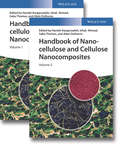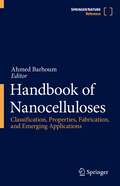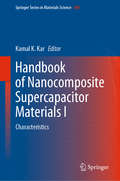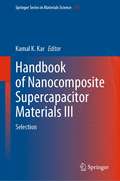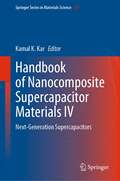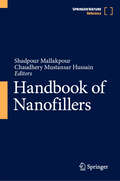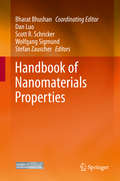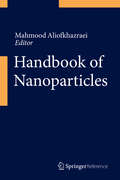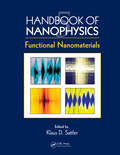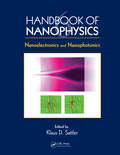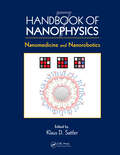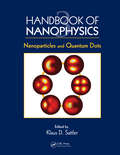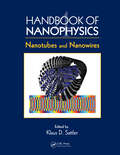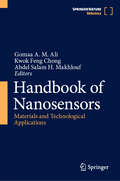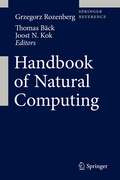- Table View
- List View
Handbook of Nano-Optics and Nanophotonics
by Motoichi OhtsuIn the 1990s, optical technology and photonics industry developed fast, but further progress became difficult due to a fundamental limit of light known as the diffraction limit. This limit could be overcome using the novel technology of nano-optics or nanophotonics in which the size of the electromagnetic field is decreased down to the nanoscale and is used as a carrier for signal transmission, processing, and fabrication. Such a decrease beyond the diffraction limit is possible by using optical near-fields. The true nature of nano-optics and nanophotonics involves not only their abilities to meet the above requirements but also their abilities to realize qualitative innovations in photonic devices, fabrication techniques, energy conversion and information processing systems. The objective of this work is to review the innovations of optical science and technology by nano-optics and nanophotonics. While in conventional optical science and technology, light and matter are discussed separately, in nano-optics and nanophotonics, light and matter have to be regarded as being coupled to each other, and the energy flow between nanoparticles is bidirectional. This means that nano-optics and nanophotonics have to be regarded as a technology fusing optical fields and matter. This unique work reviews and covers the most recent topics of nano-optics, applications to device operations, fabrication techniques, energy conversion, information processing, architectures and algorithms. Each chapter is written by the leading scientists in the relevant field. Thus, this work will provide high-quality scientific and technical information to scientists, engineers, and graduate students who are and will be engaged in R&D of nano-optics and nanophotonics. Especially, the topics to be covered by this work will be popularly used by the engineers in the rapidly growing market of the optical energy conversion.
Handbook of Nanobioelectrochemistry: Application in Devices and Biomolecular Sensing
by Pranjal Chandra Uday Pratap AzadThis handbook comprehensively reviews different nanomaterials and modern electrochemical approaches used in the point-of-care analysis of biomolecules. It describes the importance, significance, and application of various kinds of smart nanomaterials and their integration with modern electrochemical techniques for the point-of-care diagnosis of biologically important biomolecules. The interaction between bio-systems and nanomaterials have been discussed in this book using advanced electrochemical methods and characterizing techniques. It describes the combination of classical and modern methodologies for the synthesis of metal nanoparticles/nanoclusters and modern electrochemical techniques for the early-stage detection and point-of-care diagnosis of cancer and other infectious disease such as SARS, influenza, tuberculosis (TB), and hepatitis. Finally, the book provides an accessible and readable summary of the use of nanomaterial for understanding the electrochemical reaction taking place at nano-bio interfaces in electrochemical biomolecular detection and analysis. The book bridges the gap and strengthens the relationship between electrochemists, material scientists, and biomolecular scientists who are directly or indirectly associated with the field of such point-of-care diagnostics.
Handbook of Nanocellulose and Cellulose Nanocomposites, 2 Volume Set
by Sabu Thomas Alain Dufresne Hanieh Kargarzadeh Ishak AhmadAn up-to-date and comprehensive overview summarizing recent achievements, the state of the art, and trends in research into nanocellulose and cellulose nanocomposites. Following an introduction, this ready references discusses the characterization as well surface modification of cellulose nanocomposites before going into details of the manufacturing and the self-assembly of such compounds. After a description of various alternatives, including thermoplastic, thermosetting, rubber, and fully green cellulose nanocomposites, the book continues with their mechanic and thermal properties, as well as crystallization and rheology behavior. A summary of spectroscopic and water sorption properties precedes a look at environmental health and safety of these nanocomposites. With its coverage of a wide variety of materials, important characterization tools and resulting applications, this is an essential reference for beginners as well as experienced researchers.
Handbook of Nanocelluloses: Classification, Properties, Fabrication, and Emerging Applications
by Ahmed BarhoumThis Handbook covers the fundamental aspects, experimental setup, synthesis, properties, and characterization of different nanocelluloses. It also explores the technology challenges of nanocelluloses and the emerging applications and the global markets of nanocelluloses-based systems. In particular, this book: · Covers the history of nanocelluloses, types and classifications, fabrication techniques, critical processing parameters, physical and chemical properties, surface functionalization, and other treatments to allow practical applications. · Covers all recent aspects of nanocelluloses technologies, from experimental set-up to industrial applications. · Includes new physical, chemical and biological techniques for nanocelluloses fabrication, in-depth treatment of their surface functionalization, and characterization. · Discusses the unique properties of nanocelluloses that can be obtained by modifying their diameter, morphology, composition and dispersion in other materials. · Discusses the properties and morphology of several kinds of dispersion in polymeric materials, such as micro/nanofiberlated cellulose, cellulose nanofibers, cellulose nanocrystals, amorphous cellulose nanoparticles, and hybrid cellulose nanomaterials. · Presents the different techniques for dispersion, and self-assembly of polymeric materials, critical parameters of synthesis, modelling and simulation, and characterization methods. · Highlights a wide range of emerging applications of nanocelluloses, e.g. drug delivery, tissue engineering, medical implants, medical diagnostics and therapy, biosensors, catalysis, energy harvesting, energy storage, water/waste treatment, papermaking, textiles, construction industry, automotive, aerospace and many more. · Provides an outlook on the opportunities and challenges for the fabrication and manufacturing of nanocelluloses in industry. · Provides an in-depth look at the nature of nanocelluloses in terms of their applicability for industrial uses. · Provides in-depth insight and review on most recent types of nanocelluloses-based systems of unique structures and compositions. · Highlights the challenges and interdisciplinary perspective of nanocelluloses-based systems in science, biology, engineering, medicine, and technology, incorporating both fundamentals and applications.- Demonstrates how cutting-edge developments in nanofibers translate into real-world innovations in a range of industry sectors. This Handbook is a valuable reference for materials scientists, biologists, physicians, chemical, biomedical, manufacturing and mechanical engineers working in R&D industry and academia, who want to learn more about how nanocelluloses-based systems are commercially applied.
Handbook of Nanocomposite Supercapacitor Materials I: Characteristics (Springer Series in Materials Science #300)
by Kamal K. KarThis book delivers a comprehensive overview of the characteristics of several types of materials that are widely used in the current era of supercapacitors; namely, architectured carbon materials, transition metal oxides and conducting polymers. It provides readers with a complete introduction to the fundamentals of supercapacitors, including the development of new electrolytes and electrodes, while highlighting the advantages, challenges, applications and future of these materials. This book is part of the Handbook of Nanocomposite Supercapacitor Materials. Supercapacitors have emerged as promising devices for electrochemical energy storage, playing an important role in energy harvesting for meeting the current demands of increasing global energy consumption. The handbook covers the materials science and engineering of nanocomposite supercapacitors, ranging from their general characteristics and performance to materials selection, design and construction. Covering both fundamentals and recent developments, this handbook serves a readership encompassing students, professionals and researchers throughout academia and industry, particularly in the fields of materials chemistry, electrochemistry, and energy storage and conversion. It is ideal as a reference work and primary resource for any introductory senior-level undergraduate or beginning graduate course covering supercapacitors.
Handbook of Nanocomposite Supercapacitor Materials II: Performance (Springer Series in Materials Science #302)
by Kamal K. KarThis book covers the performance aspects of nanocomposite supercapacitor materials based on transition metal oxides, activated carbon, carbon nanotubes, carbon nanofibers, graphene and conducting polymers. It compares the performance of simple electrode materials versus binary and ternary composites, while highlighting the advantages and challenges of different supercapacitor electrode materials.This book is part of the Handbook of Nanocomposite Supercapacitor Materials. Supercapacitors have emerged as promising devices for electrochemical energy storage, playing an important role in energy harvesting for meeting the current demands of increasing global energy consumption. The handbook covers the materials science and engineering of nanocomposite supercapacitors, ranging from their general characteristics and performance to materials selection, design and construction. Covering both fundamentals and recent developments, this handbook serves a readership encompassing students, professionals and researchers throughout academia and industry, particularly in the fields of materials chemistry, electrochemistry, and energy storage and conversion. It is ideal as a reference work and primary resource for any introductory senior-level undergraduate or beginning graduate course covering supercapacitors.
Handbook of Nanocomposite Supercapacitor Materials III: Selection (Springer Series in Materials Science #313)
by Kamal K. KarThis book covers the selection of nanocomposite supercapacitor materials. It describes the most important criteria behind the selection of materials for the electrode, electrolytes, separator and current collectors, which comprise the key components of supercapacitors for advanced energy storage. It discusses the influence on each material on the unique electrochemical properties of nanocomposite supercapacitors with respect to their energy storage mechanism and stability under extreme and unpredictable conditions.This book is part of the Handbook of Nanocomposite Supercapacitor Materials. Supercapacitors have emerged as promising devices for electrochemical energy storage, playing an important role in energy harvesting for meeting the current demands of increasing global energy consumption. The handbook covers the materials science and engineering of nanocomposite supercapacitors, ranging from their general characteristics and performance to materials selection, design and construction. Covering both fundamentals and recent developments, this handbook serves a readership encompassing students, professionals and researchers throughout academia and industry, particularly in the fields of materials chemistry, electrochemistry, and energy storage and conversion. It is ideal as a reference work and primary resource for any introductory senior-level undergraduate or beginning graduate course covering supercapacitors.
Handbook of Nanocomposite Supercapacitor Materials IV: Next-Generation Supercapacitors (Springer Series in Materials Science #331)
by Kamal K. KarThis book covers next-generation nanocomposite supercapacitor materials. It deals with a wide range of emerging and sustainable supercapacitors based on, e.g., low-dimensional materials including transition metal oxides, carbons, Mxenes, etc., and metal-organic frameworks. Additionally, it features up-to-date coverage of advanced supercapacitors such as 3D printing, atomic layer deposition, recycling, quantum, on-chip, shape memory, self-healing, and micro-scale supercapacitors.This book is part of the Handbook of Nanocomposite Supercapacitor Materials. Supercapacitors have emerged as promising devices for electrochemical energy storage, playing an important role in energy harvesting for meeting the current demands of increasing global energy consumption. The handbook covers the materials science and engineering of nanocomposite supercapacitors, ranging from their general characteristics and performance to materials selection, design and construction.Covering both fundamentals and recent developments, this handbook serves a readership encompassing students, professionals and researchers throughout academia and industry, particularly in the fields of materials chemistry, electrochemistry, and energy storage and conversion. It is ideal as a reference work and primary resource for any introductory senior-level undergraduate or beginning graduate course covering supercapacitors.
Handbook of Nanoencapsulation: Preparation, Characterization, Delivery, and Safety of Nutraceutical Nanocomposites
by Jasmeet KourNutraceutical encapsulation envelopes protection of products from oxidative damage, controlled delivery of nanoencapsulated nutraceuticals and improved nutraceutical bioavailability as well as biological action. It is a promising technique to ensure the stabilization of such labile compounds and to protect the core ingredients from premature reactions and interactions In a comprehensive manner, the Handbook of Nanoencapsulation: Preparation, Characterization, Delivery and Safety of Nutraceutical Nanocomposites presents various nanosystems/nanocarriers, physical and chemical techniques used in encapsulation of various nutraceuticals, and the targeted delivery of various significant nutraceuticals. This book bridges the gap between academia and research as it encompasses the ubiquitous applications of nanoencapsulation technique used on significant nutraceuticals derived from plants, animals as well as microalgae. Key Features: Provides a quick and easy access to major plant, animal and microalgae derived nutraceutical ingredients Discusses nanoencapsulation techniques for protection and targeted release of various food bioactive ingredients. Covers safety, bioaccessibility and multiple applications of nanoencapsulated nutraceuticals in the food industry Unveiling pivotal aspects of nanoencapsulation of significant nutraceuticals, this book is a valuable resource for researchers, food toxicologists, food scientists, nutritionists, and scientists in medicinal research.
Handbook of Nanofillers
by Chaudhery Mustansar Hussain Shadpour MallakpourThis handbook presents the basic concepts of nanofillers, their types, unique properties, including their structure, surface area, properties & real-time applications. The book discusses basics of nanofillers, their types, their structures, and properties as well as several applications. The chapters in this book cover latest developments applications in the food industry, drug delivery, tissue technology, biosensors, electrically conductive polymers and insulators, green catalysis, and environmental remediation. The contents of these book will be useful to researchers, industry practitioners, and academics across disciplines of materials science, chemistry, biomedicine, industrial engineering and chemical engineering.
Handbook of Nanomaterials Properties
by Bharat Bhushan Dan Luo Scott R. Schricker Wolfgang Sigmund Stefan ZauscherNanomaterials attract tremendous attention in recent researches. Although extensive research has been done in this field it still lacks a comprehensive reference work that presents data on properties of different Nanomaterials. This Handbook of Nanomaterials Properties will be the first single reference work that brings together the various properties with wide breadth and scope.
Handbook of Nanoparticles
by Mahmood AliofkhazraeiThis Handbook covers all aspects of Nanoparticles, from their preparation to their practical application. The chapters present different ways to synthesize nanometer particles, as well as their functionalization and other surface treatments to allow them to a practical use. Several industrial applications of such nanometer particles are also covered in this Handbook. It is a complete reference for those working with Nanotechnology at the lab level, from students to professionals.
Handbook of Nanophysics: Clusters and Fullerenes (Handbook of Nanophysics)
by Klaus D. SattlerThe field of nanoscience was pioneered in the 1980s with the groundbreaking research on clusters, which later led to the discovery of fullerenes. Handbook of Nanophysics: Clusters and Fullerenes focuses on the fundamental physics of these nanoscale materials and structures. Each peer-reviewed chapter contains a broad-based introduction and enhances
Handbook of Nanophysics: Functional Nanomaterials (Handbook of Nanophysics)
by Klaus D. SattlerHandbook of Nanophysics: Functional Nanomaterials illustrates the importance of tailoring nanomaterials to achieve desired functions in applications. Each peer-reviewed chapter contains a broad-based introduction and enhances understanding of the state-of-the-art scientific content through fundamental equations and illustrations, some in color.This
Handbook of Nanophysics: Nanoelectronics and Nanophotonics (Handbook of Nanophysics)
by Klaus D. SattlerMany bottom-up and top-down techniques for nanomaterial and nanostructure generation have enabled the development of applications in nanoelectronics and nanophotonics. Handbook of Nanophysics: Nanoelectronics and Nanophotonics explores important recent applications of nanophysics in the areas of electronics and photonics. Each peer-reviewed c
Handbook of Nanophysics: Nanomedicine and Nanorobotics
by Klaus D. SattlerThe tools of nanodiagnostics, nanotherapy, and nanorobotics are expected to revolutionize the future of medicine, leading to presymptomatic diagnosis of disease, highly effective targeted treatment therapy, and minimum side effects. Handbook of Nanophysics: Nanomedicine and Nanorobotics presents an up-to-date overview of the application of nan
Handbook of Nanophysics: Nanoparticles and Quantum Dots (Handbook of Nanophysics)
by Klaus D. SattlerIn the 1990s, nanoparticles and quantum dots began to be used in optical, electronic, and biological applications. Now they are being studied for use in solid-state quantum computation, tumor imaging, and photovoltaics. Handbook of Nanophysics: Nanoparticles and Quantum Dots focuses on the fundamental physics of these nanoscale materials and struct
Handbook of Nanophysics: Nanotubes and Nanowires
by Klaus D. SattlerIntensive research on fullerenes, nanoparticles, and quantum dots in the 1990s led to interest in nanotubes and nanowires in subsequent years. Handbook of Nanophysics: Nanotubes and Nanowires focuses on the fundamental physics and latest applications of these important nanoscale materials and structures. Each peer-reviewed chapter contains a broad-
Handbook of Nanophysics: Principles and Methods (Handbook of Nanophysics)
by Klaus D. SattlerCovering the key theories, tools, and techniques of this dynamic field, Handbook of Nanophysics: Principles and Methods elucidates the general theoretical principles and measurements of nanoscale systems. Each peer-reviewed chapter contains a broad-based introduction and enhances understanding of the state-of-the-art scientific content through fund
Handbook of Nanoscience, Engineering, and Technology (Electrical Engineering Handbook)
by William A. Goddard, Donald W. Brenner, Sergey E. Lyshevski and Gerald J. IafrateIn his 1959 address, "There is Plenty of Room at the Bottom," Richard P. Feynman speculated about manipulating materials atom by atom and challenged the technical community "to find ways of manipulating and controlling things on a small scale." This visionary challenge has now become a reality, with recent advances enabling atomistic-level tailoring and control of materials. Exemplifying Feynman’s vision, Handbook of Nanoscience, Engineering, and Technology, Third Edition continues to explore innovative nanoscience, engineering, and technology areas. Along with updating all chapters, this third edition extends the coverage of emerging nano areas even further. Two entirely new sections on energy and biology cover nanomaterials for energy storage devices, photovoltaics, DNA devices and assembly, digital microfluidic lab-on-a-chip, and much more. This edition also includes new chapters on nanomagnet logic, quantum transport at the nanoscale, terahertz emission from Bloch oscillator systems, molecular logic, electronic optics in graphene, and electromagnetic metamaterials. With contributions from top scientists and researchers from around the globe, this color handbook presents a unified, up-to-date account of the most promising technologies and developments in the nano field. It sets the stage for the next revolution of nanoscale manufacturing—where scalable technologies are used to manufacture large numbers of devices with complex functionalities.
Handbook of Nanoscopy, 2 Volume Set
by Stephen J. Pennycook Dirk Van Dyck Gustaaf Van TendelooThis completely revised successor to the Handbook of Microscopy supplies in-depth coverage of all imaging technologies from the optical to the electron and scanning techniques. Adopting a twofold approach, the book firstly presents the various technologies as such, before going on to cover the materials class by class, analyzing how the different imaging methods can be successfully applied. It covers the latest developments in techniques, such as in-situ TEM, 3D imaging in TEM and SEM, as well as a broad range of material types, including metals, alloys, ceramics, polymers, semiconductors, minerals, quasicrystals, amorphous solids, among others. The volumes are divided between methods and applications, making this both a reliable reference and handbook for chemists, physicists, biologists, materials scientists and engineers, as well as graduate students and their lecturers.
Handbook of Nanosensors: Materials and Technological Applications
by Gomaa A. M. Ali Abdel Salam H. Makhlouf Kwok Feng ChongThis book discusses the advances in sensor technologies and sensing efficiency. It highlights different sensor applications, including humidity, gas, fluorescent, biological, optical, radiation, etc. The chapters discuss recycled and biodegradable materials-based sensors as well as sensing techniques and theories. The different approaches employed to modify the electrode surfaces of sensors to lower the overpotential, enhance sensitivity to enrich the desired species and/or lessen the influence of interferences are also covered. This handbook is structured in seven sections including fundamentals of sensor technologies, types of sensors, and medical, biological, environmental, and industrial applications of sensors.
Handbook of Nanotechnology in Nutraceuticals
by Shakeel Ahmed Tanima Bhattacharya Annu Akbar AliNanotechnology has been emerging as an important tool in the nutraceutical and food industries to improve the overall quality of life. Nanotechnology has established a new horizon by bestowing modified properties on nanomaterials and applying them to the production of nanoformulations, nutritional supplements, and the food industry. The Handbook of Nanotechnology in Nutraceuticals highlights the impact of nanotechnology on the food industries. The book focuses on the application of nanotechnology in nutraceuticals and the food industry to improve the overall quality of life. The book also addresses some important applications of nano-nutraceuticals in the treatment of different diseases, such as oxidative stress, cancer, neurodegenerative disorders, cardiovascular diseases, and so on. Features • Presents a scientometric approach to analyze the emergence of nano-nutraceuticals in cancer prevention and treatment • Examines various strategies employed to prepare nanocarrier systems, such as nanoparticles, nanostructure lipids, phospholipid-based nanocarriers, polysaccharide-based nanostructures, and metal nanoparticles • Discusses various regulatory issues related to nanotechnology and their application in different fields This book is a valuable reference for nanotechnologists, scientists, and researchers working in the field of food technology, food science, pharmaceuticals, and nutraceuticals.
Handbook of National Communication Networks for Public Safety Next-Generation Advances: Next-Generation Advances
by Madhu S. Singh, Ph.D.The U.S. Department of Homeland Security created the FirstNet Authority for the purpose of building and operating a nationwide public safety broadband network. Handbook of National Communication Networks for Public Safety: Next-Generation Advances traces the evolution of the National Public Safety Broadband Network (NPSBN). The book is composed of three major sections, each section containg specific contents: Advent of FirstNet National Public Safety Broadband Network Evolution of National Public Safety Broadband Network (NPSBN) Future Innovations, Opportunities, and Challenges in Public Safety The book covers planning, architecting/designing of networks and services, deployment, and operations, as well as enhancements to cover all states and territories of the United States. Other highlights covered in the book include: 4G/ 5G/ 6G mobile broadband technology The FirstNet and NPSBN ecosystem The dedicated and secure public safety network for first responders Terrestrial and satellite based broadband network and services for public safety 911 and location-based services Quality of service Cybersecurity AI/AR opportunities, network interoperability and challenges The book features technical details of the NPSBN and services. It explains how enhanced devices make the NPSBN accessible anywhere and anytime to public safety personnel over dedicated and secure LTE/ 5G networks. It discusses how public safety challenges differ from urban to rural areas, from mainland to U.S. territories, and from land to sea coverage. The book concludes with an analysis on future challenges and presents approaches for successful resolution of these issues.
Handbook of Natural Computing
by Thomas Bäck Grzegorz Rozenberg Joost N. KokNatural Computing is the field of research that investigates both human-designed computing inspired by nature and computing taking place in nature, i.e., it investigates models and computational techniques inspired by nature and also it investigates phenomena taking place in nature in terms of information processing. Examples of the first strand of research covered by the handbook include neural computation inspired by the functioning of the brain; evolutionary computation inspired by Darwinian evolution of species; cellular automata inspired by intercellular communication; swarm intelligence inspired by the behavior of groups of organisms; artificial immune systems inspired by the natural immune system; artificial life systems inspired by the properties of natural life in general; membrane computing inspired by the compartmentalized ways in which cells process information; and amorphous computing inspired by morphogenesis. Other examples of natural-computing paradigms are molecular computing and quantum computing, where the goal is to replace traditional electronic hardware, e.g., by bioware in molecular computing. In molecular computing, data are encoded as biomolecules and then molecular biology tools are used to transform the data, thus performing computations. In quantum computing, one exploits quantum-mechanical phenomena to perform computations and secure communications more efficiently than classical physics and, hence, traditional hardware allows. The second strand of research covered by the handbook, computation taking place in nature, is represented by investigations into, among others, the computational nature of self-assembly, which lies at the core of nanoscience, the computational nature of developmental processes, the computational nature of biochemical reactions, the computational nature of bacterial communication, the computational nature of brain processes, and the systems biology approach to bionetworks where cellular processes are treated in terms of communication and interaction, and, hence, in terms of computation. We are now witnessing exciting interaction between computer science and the natural sciences. While the natural sciences are rapidly absorbing notions, techniques and methodologies intrinsic to information processing, computer science is adapting and extending its traditional notion of computation, and computational techniques, to account for computation taking place in nature around us. Natural Computing is an important catalyst for this two-way interaction, and this handbook is a major record of this important development.


